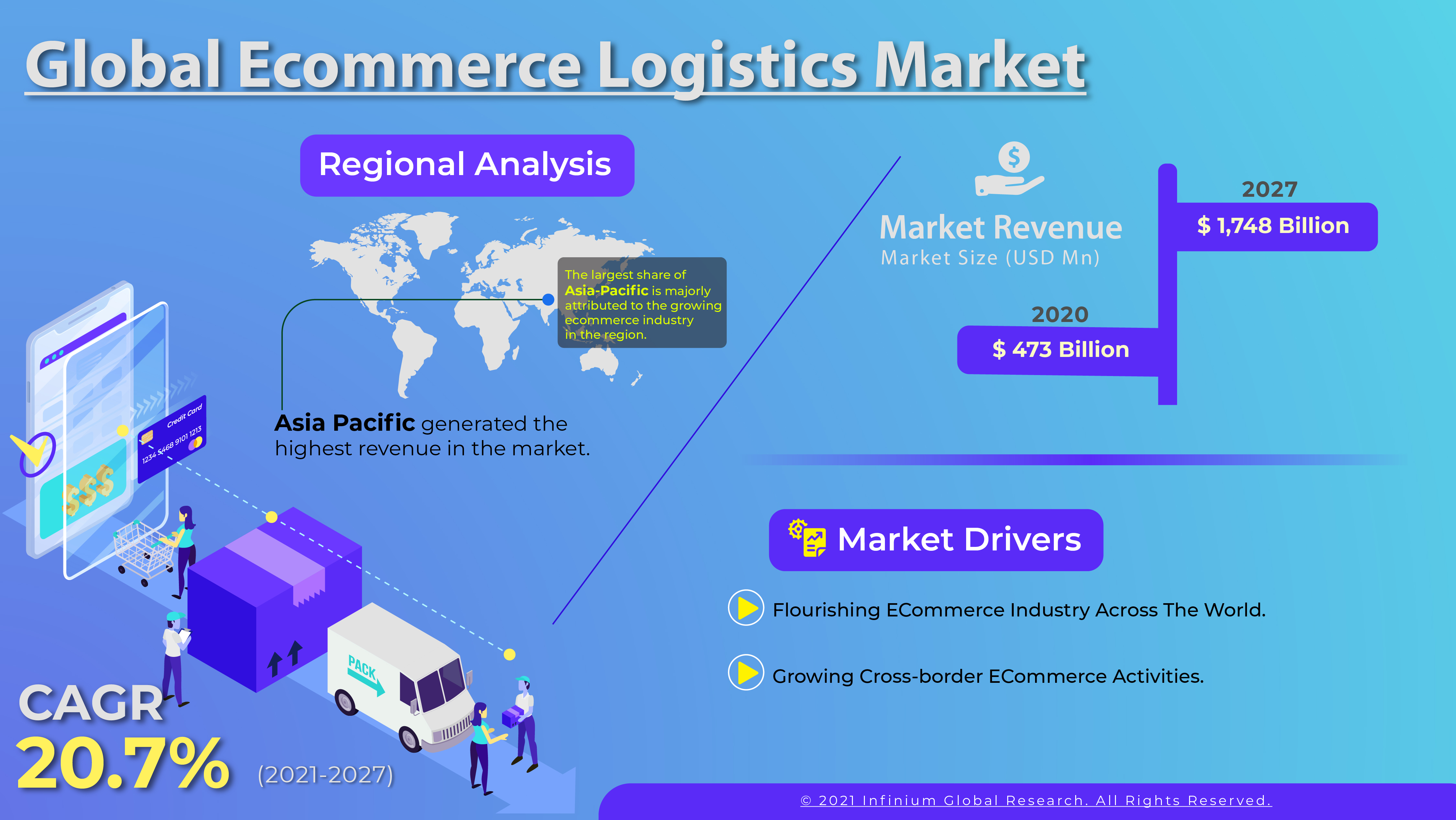Ecommerce Logistics Market (Operational Area - Domestic, and International; Service Type - Transportation, Warehousing, and Value-added Services; Mode of Transportation - Railways, Roadways, Waterways, and Airways): Global Industry Analysis, Trends, Size, Share and Forecasts to 2027
A recent report published by
Infinium Global Research on ecommerce logistics market provides an in-depth
analysis of segments and sub-segments in the global as well as regional ecommerce logistics market. The study also highlights the impact of drivers,
restraints, and macro indicators on the global and regional ecommerce logistics
market over the short term as well as long term. The report is a comprehensive
presentation of trends, forecast, and dollar values of the global ecommerce logistics market. According to the report, the global ecommerce logistics
market is projected to grow at a CAGR of 20.7% over the forecast period of
2021-2027, growing from nearly USD 473 billion in 2020 to about USD 1,748
billion in 2027.

Market Insight
With advancements in technology
and the flourishing ecommerce industry, the logistics industry is witnessing
several changes. Logistic activities such as inventory management,
warehousing, packaging, labeling, billing, shipping, payment collection, return,
and exchange play a significant role in the ecommerce industry. Several ecommerce companies manage the logistic activities by themselves, while some
companies outsource the operations to the logistic service providers. ecommerce logistics starts with moving goods from the manufacturer until it ends up at
the customer’s destination. The logistics providers are implementing
technological support to the customer. The logistics service providers such as
FedEx, DHL, UPS, and Kuehne + Nagel are some of the leading players in the ecommerce logistics market.
The COVID-19 outbreak had a
serious impact on the global supply chains. The transportation and logistics
operations witnessed heavy stress over the period of the pandemic. The
government across several countries implemented lockdown restrictions.
Moreover, the ecommerce vendors were compelled to sell only essential goods
such as foods, beverages, medicines, medical products, personal care products,
and others over the pandemic period. Thus, the demand for logistics dropped
during the pandemic, as the sale of non-essential products was stopped.
Furthermore, issues such as closed warehouses, restricted transport, and
shortage of labor were prevalent over the period of pandemics. Nevertheless, as
the pandemic crisis faded, the logistics activities were back to their normal
level. The demand for ecommerce logistics increased, as consumers' preference
for online retail channels increased over the period of pandemics. This
propelled the growth of ecommerce logistics over a short period and is expected
to drive the market in the future.
The flourishing ecommerce industry
across the world is majorly driving the growth of the ecommerce logistics
market. As the penetration of the internet increased, particularly in the developing
regions, the usage of ecommerce grew. With the rise in ecommerce usage, the
demand for ecommerce logistics also increased. Moreover, the growing
cross-border ecommerce activities are further augmenting the adoption of ecommerce logistics. Several ecommerce platforms such as Alibaba, and Etsy are
using cross-border activities. However, the lack of system security poses a
major challenge to the market players. Nevertheless, the development of
advanced technologies such as AI, IoT, and 5G is expected to offer growth
opportunities to the market players. The vendors are able to streamline their
operations and provide a better experience to the customers by adopting these
modern technologies.
In terms of region, the global ecommerce logistics market is segmented into North America, Europe,
Asia-Pacific, and the Rest of the World. The Asia-Pacific generated the highest
revenue in the global ecommerce logistics market, and it is expected to grow at
the fastest rate over the forecast period. The largest share of Asia-Pacific is
majorly attributed to the growing ecommerce industry in the region. Moreover,
countries such as China, South Korea, and India have the largest consumer pool
for ecommerce in the world. This has increased the demand for logistics in the
region. Furthermore, the development of logistics infrastructure in the region
is supporting the growth of the industry in the Asia Pacific. On the other
hand, North America accounted for the second-largest share in the global ecommerce logistics market. The presence of the leading ecommerce vendors in
the region is majorly driving the growth of the market in North America.
Segment Covered
The report on the global ecommerce
logistics market covers segments such as operational area, service type, and
mode of transportation. On the basis of operational area, the sub-markets
include domestic, and international. On the basis of service type, the
sub-markets include transportation, warehousing, and value-added services. On
the basis of mode of transportation, the sub-markets include railways,
roadways, waterways, and airways.
Companies Profiled:
The report provides profiles of
the companies in the market such as DHL International GmbH, FedEx Corporation,
XPO Logistics, Inc., United Parcel Service of America, Inc., Kuehne + Nagel
International AG, Amazon.com, Inc., CEVA Holdings LLC, DTDC Express Ltd., Gati
Limited, and Agility Public Warehousing Company K.S.C.P.
Report Highlights:
The report provides deep insights
into the demand forecasts, market trends, and micro and macro indicators. In
addition, this report provides insights into the factors that are driving and
restraining the growth in this market. Moreover, The IGR-Growth Matrix analysis
given in the report brings an insight into the investment areas that existing
or new market players can consider. The report provides insights into the market
using analytical tools such as Porter's five forces analysis and DRO analysis
of ecommerce logistics market. Moreover, the study highlights current market
trends and provides forecast from 2021-2027. We also have highlighted future
trends in the market that will affect the demand during the forecast period.
Moreover, the competitive analysis given in each regional market brings an
insight into the market share of the leading players.
Please Choose One of them.